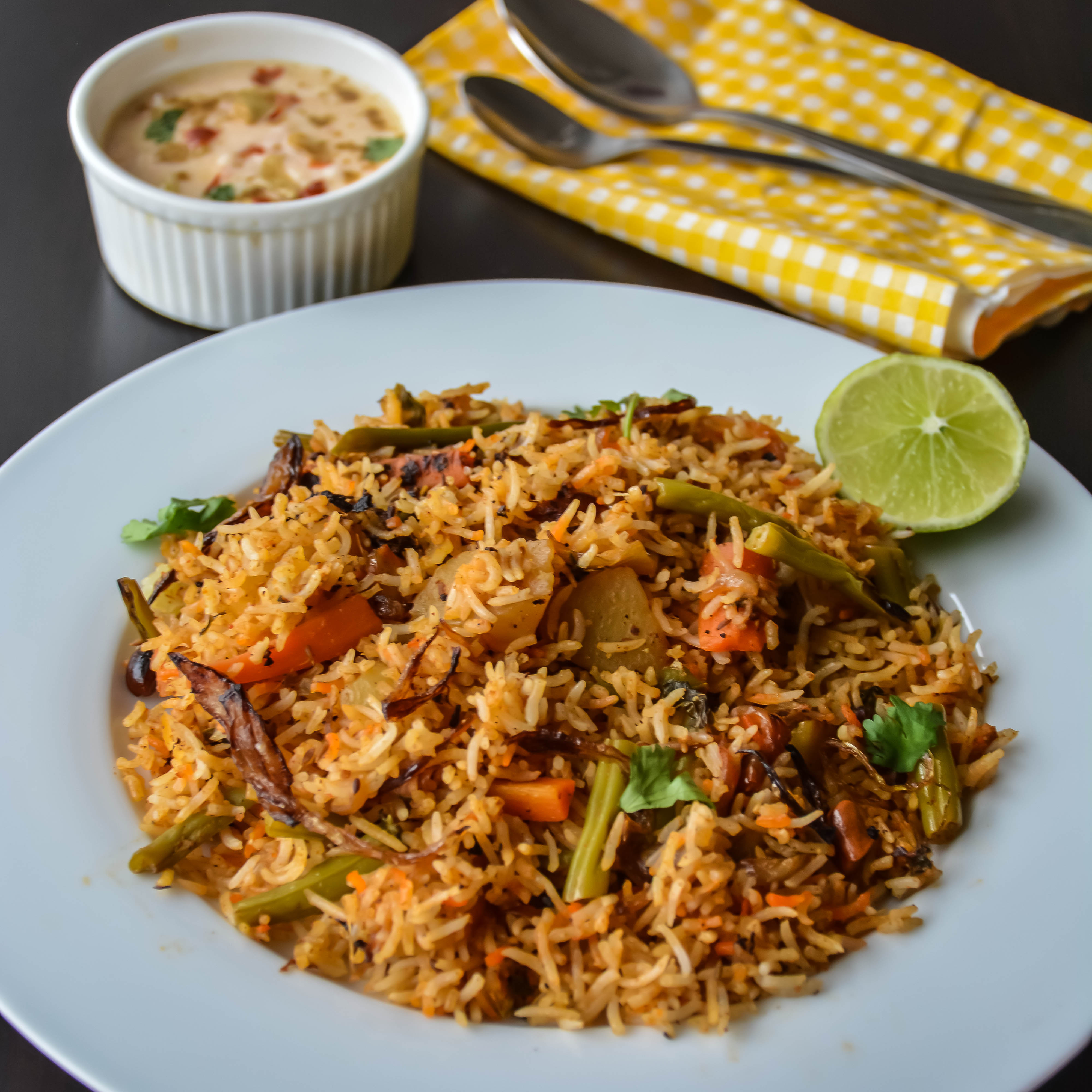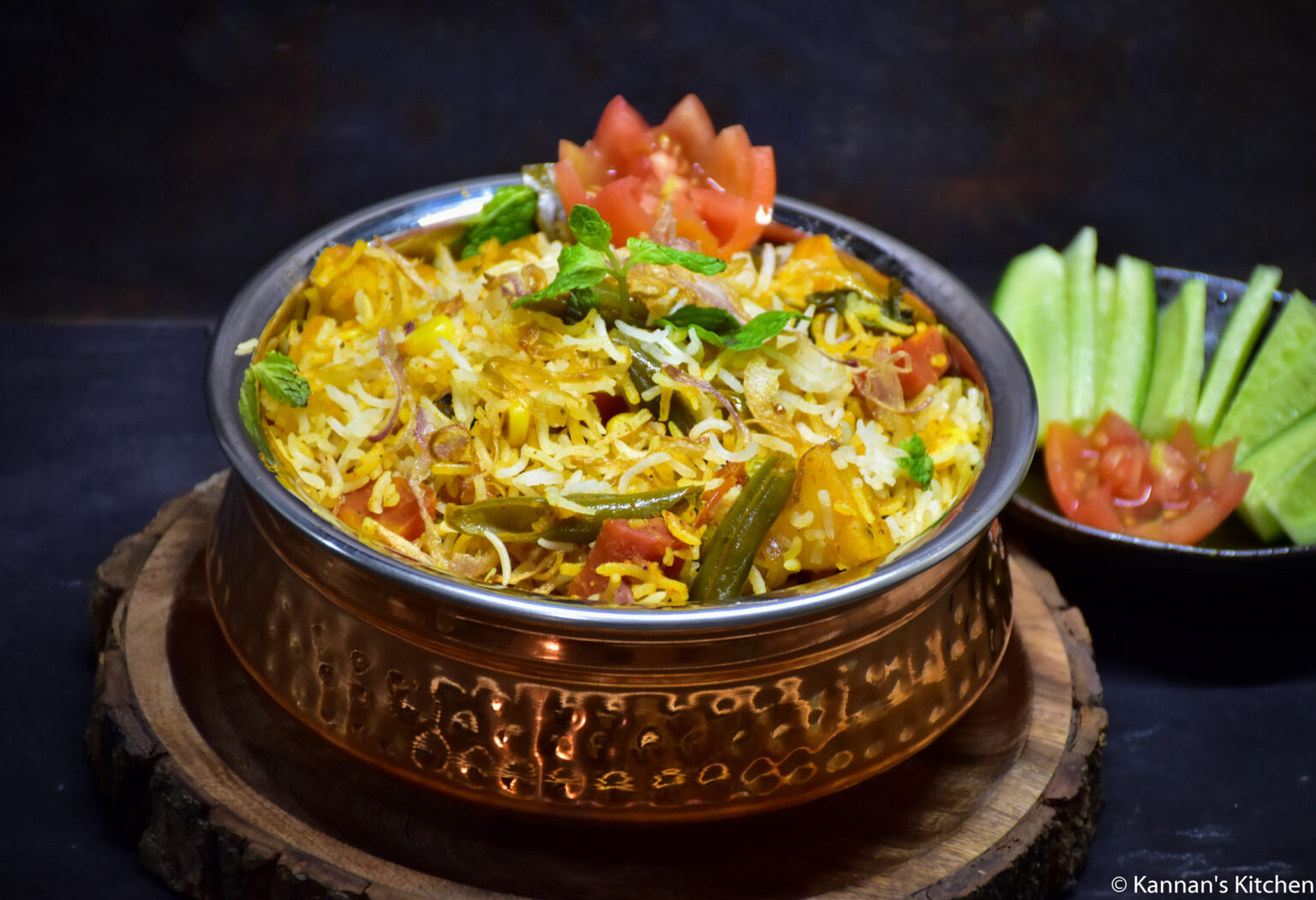Indulge in the delectable 1 kg veg biryani recipe, a masterpiece that tantalizes taste buds and captivates the senses. This exquisite dish, a symphony of fragrant spices, tender vegetables, and fluffy rice, promises an unforgettable culinary experience.
Our comprehensive guide will lead you through the intricacies of preparing this beloved dish, ensuring every step is executed with precision. From the selection of the finest ingredients to the meticulous layering and cooking techniques, we’ll empower you to recreate this culinary marvel in your own kitchen.
Ingredients for 1 kg Veg Biryani
Preparing a delicious and aromatic 1 kg vegetarian biryani requires a combination of fresh vegetables, fragrant spices, and essential ingredients that work together to create a flavorful dish.
Vegetables
- Carrots (100 grams):Cut into 1-inch pieces for a vibrant color and sweet flavor.
- Green peas (100 grams):Add a touch of freshness and sweetness to the biryani.
- Cauliflower (150 grams):Cut into florets for a tender and nutty flavor.
- Potatoes (200 grams):Boiled and cut into cubes for a soft and starchy texture.
- Capsicum (100 grams):Cut into strips for a crunchy texture and mild sweetness.
- Onion (200 grams):Sliced thinly for a caramelized flavor.
- Ginger-garlic paste (2 tablespoons):Provides a pungent and aromatic base.
Spices and Herbs
- Garam masala (1 teaspoon):A blend of spices that adds warmth and depth of flavor.
- Cumin seeds (1 teaspoon):Enhances the earthiness of the dish.
- Coriander powder (1 tablespoon):Provides a citrusy and nutty flavor.
- Turmeric powder (1 teaspoon):Adds a vibrant yellow color and a slightly bitter taste.
- Red chili powder (1 teaspoon):Adjust according to taste for spiciness.
- Bay leaves (2-3):Imparts a subtle fragrance.
- Clove (3-4):Adds a hint of warmth and sweetness.
- Cinnamon stick (1):Provides a subtle sweetness and aroma.
- Fresh coriander leaves (for garnishing):Adds a refreshing touch and enhances the presentation.
Essential Ingredients
- Basmati rice (500 grams):Long-grained rice known for its aromatic and fluffy texture.
- Yogurt (200 grams):Marinates the vegetables and rice, adding tenderness and a tangy flavor.
- Ghee (100 grams):Clarified butter that provides a rich and nutty flavor.
- Lemon juice (2 tablespoons):Adds a hint of acidity and freshness.
- Water (as required):Adjust the amount of water based on the consistency of the rice.
Step-by-Step Cooking s
Prepare a delicious and flavorful 1 kg Veg Biryani by following these step-by-step cooking s.
Preparing the Vegetables and Rice, 1 kg veg biryani recipe
- Heat oil in a large pot over medium heat. Add the chopped vegetables and sauté until tender.
- In a separate pot, bring water to a boil. Add the rice and cook according to the package s.
Layering the Biryani
- Spread half of the cooked vegetables evenly in the bottom of a large pot or Dutch oven.
- Top with half of the cooked rice.
- Sprinkle with half of the remaining spices.
- Repeat the layers.
Simmering and Sealing
- Add enough water to cover the rice by about 1 inch.
- Bring to a boil, then reduce heat to low and simmer for 15-20 minutes, or until the rice is cooked through and the liquid has been absorbed.
- Seal the pot with dough or foil and let it rest for 10-15 minutes before serving.
Serving and Presentation: 1 Kg Veg Biryani Recipe
Once the biryani is cooked, it’s time to fluff it before serving to separate the grains and enhance its texture. Use a fork or a large spoon to gently lift the rice from the bottom of the pot and fluff it up, taking care not to break the grains.
Adopting a vegan lifestyle offers numerous health benefits. Studies have shown that vegans have lower rates of heart disease, type 2 diabetes, and some types of cancer. Additionally, a vegan diet is environmentally sustainable, as it reduces the demand for animal products that contribute to greenhouse gas emissions.
Traditionally, biryani is served with raita, a cooling yogurt-based sauce, and salad. Raita helps balance the richness of the biryani, while the salad adds freshness and crunch. Other accompaniments that complement biryani include onion slices, lemon wedges, and papadum (crispy lentil crackers).
The vegan lifestyle, characterized by a plant-based diet, has gained significant popularity in recent years. Veganism offers a multitude of health benefits, including reduced risk of chronic diseases, improved heart health, and better weight management. Moreover, it promotes environmental sustainability by reducing the demand for animal products.
Garnishing and Enhancing Presentation
To enhance the presentation of the biryani, consider garnishing it with fresh coriander leaves, mint leaves, or saffron strands. These garnishes add a pop of color and freshness to the dish. You can also drizzle a little ghee or melted butter on top to give it a glossy finish.
Outcome Summary
As you savor each flavorful bite of your homemade 1 kg veg biryani, let its vibrant colors and aromatic essence transport you to the vibrant streets of India. This dish, steeped in tradition and culinary artistry, is a testament to the boundless possibilities of vegetarian cuisine.
Whether you’re a seasoned cook or a culinary novice, this recipe will guide you towards creating a dish that will impress your family and friends. So gather your ingredients, don your apron, and embark on a culinary adventure that will leave a lasting impression.
FAQ Corner
How long does it take to cook 1 kg of veg biryani?
The total cooking time for 1 kg of veg biryani is approximately 60-75 minutes, including preparation and cooking.
What is the best type of rice to use for biryani?
Basmati rice is the traditional choice for biryani as its long, slender grains remain separate and fluffy after cooking.
Can I use frozen vegetables for biryani?
Yes, you can use frozen vegetables for biryani. However, thaw them completely before adding them to the dish to prevent excess moisture.


